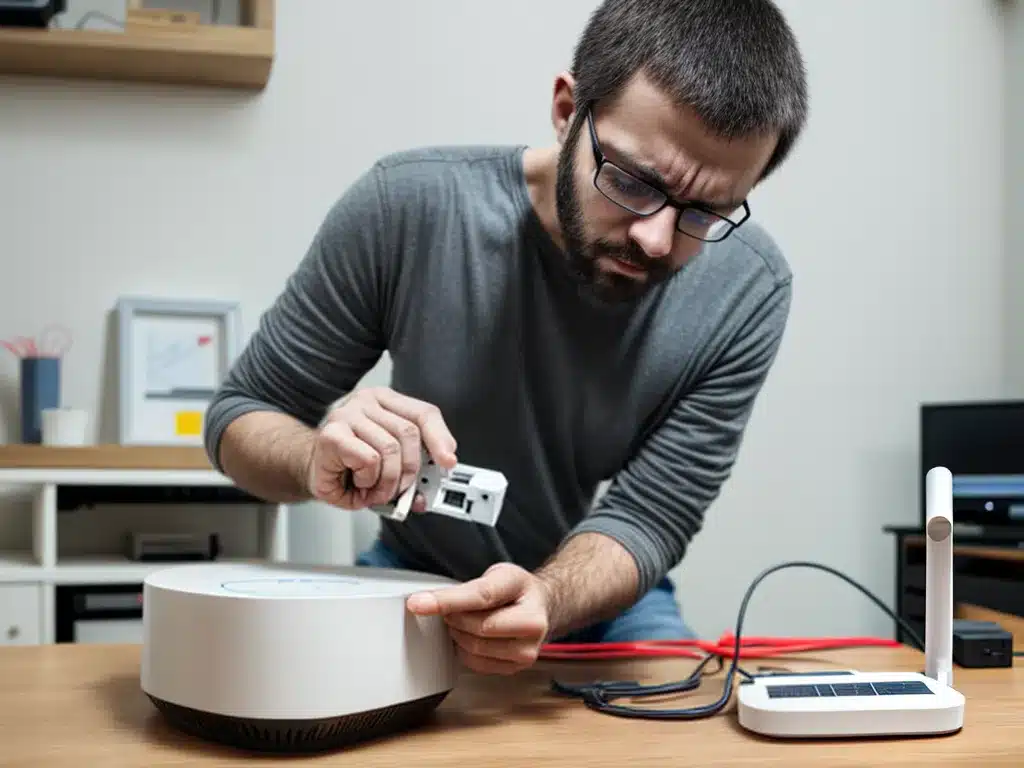
Having a strong and reliable WiFi signal in your home is essential these days. From streaming movies to video calls, a fast internet connection keeps us connected and entertained. However, router problems like weak signals, dead zones, and disconnections can disrupt our wireless experience. The good news is that you can often repair your home WiFi router yourself without having to call your internet service provider. This do-it-yourself guide will walk you through the common issues and solutions for improving your home wireless network.
Troubleshooting the Problem
Before attempting to repair your home WiFi router, it’s important to properly diagnose the problem. Here are some of the most common WiFi connectivity issues and their likely causes:
Weak Signal Strength
If you notice your WiFi signal is weak in certain areas of your home, it usually means the router’s placement isn’t optimal. Routers should be centrally located in your home, away from objects that can block the signal like appliances and thick walls. Interference from neighboring WiFi networks can also degrade your signal strength.
Slow Internet Speeds
There are a few factors that could be slowing down your internet speeds over WiFi. Having too many devices connected to your network can congest it and slow things down. Outdated router hardware may also limit wireless speeds, especially on newer devices. Distance from the router reduces throughput as well.
Dead Zones
Dead zones are areas in your home where your WiFi signal doesn’t reach well. They are usually caused by obstruction from walls and large furnishings. Wireless interference can also create dead zones if the disruption is localized.
Frequent Disconnections
If your WiFi router keeps dropping devices from the network, it likely indicates router firmware problems or overheating issues. Faulty router antennas and human-created radio interference can also interrupt connectivity.
Solutions for Common Router Problems
Once you’ve diagnosed the issue with your home WiFi network, here are some effective DIY ways to get your router working optimally again:
Optimize Router Placement
Finding the right spot for your router can fix a lot of wireless woes. Place it near the center of your home on an open shelf away from walls and electronics. Elevating the router also improves signal distribution to dead spots. Avoid encasing it inside cabinets or crowded media centers.
Update Router Firmware
Router firmware is the internal software that operates your device. Checking for and installing the latest firmware update from your manufacturer can squash bugs causing disconnections and speed issues. Updates also patch security vulnerabilities.
Change the Wireless Channel
If you suspect interference from a neighbor’s WiFi network is disrupting your signal, try switching your router to broadcast on a different channel. Download a WiFi analyzer app to view congested channels. Opt for the clearest option.
Replace the Antennas
Routers with external antennas allow you to upgrade them for longer range. High-gain directional antennas concentrate the wireless signal while multi-antenna designs provide more coverage. Just screw on the new antenna.
Add a Wireless Extender
For stubborn dead zones, a wireless range extender is an easy fix. It picks up the router’s WiFi signal and rebroadcasts it further into your home. Place the compact extender in a central dead zone.
Reset the Router
If all else fails, reset your router to factory default settings. This clears up any software problems and gives you a fresh start. Just locate the reset button on the back and hold it down for 10-15 seconds. You’ll need to reconfigure the router afterward.
Advanced Router Repairs
For more technically inclined users, there are some advanced DIY steps you can try to repair WiFi router issues:
Flash the Firmware
While firmware updates are pushed out automatically, you can manually flash the router firmware yourself. This lets you reinstall the operating system or upgrade to customized third-party firmware for better performance and features. Just be sure to pick the correct firmware file for your router model.
Change Security Settings
If your router’s wireless security protocol is outdated, manually updating to WPA2 encryption will prevent hackers from accessing your network. Disabling WPS and setting a strong WiFi password also secure your home WiFi.
Overclock the Router
Routers can sometimes be overclocked beyond factory speeds for a free performance boost. This tweak enhances WiFi range and throughput. However, it’s risky if you push the router hardware too far. Modest overclocks are safest.
Install Custom Router Software
DD-WRT and OpenWRT are open-source router firmware replacements that add tons of extras like VPN access, bandwidth monitoring, and WiFi extensions. They work great on older routers. Just be aware that installation is complex and may void your warranty.
When to Call for Professional Help
While many home router problems can be resolved with DIY troubleshooting and repairs, there are some instances when it pays to have a professional handle things:
-
If router hardware has failed or been physically damaged, replacement is likely required.
-
An ISP may need to repair the modem/router combo unit leased to you when issues arise.
-
Professional-grade routers or mesh systems are best configured by hired network technicians.
-
If you are unable to diagnose the root cause of your WiFi problems, an expert may need to investigate.
-
Major network outages affecting multiple devices require a professional diagnosis.
The right DIY repairs can breathe new life into an aging home router plagued by wireless issues. But for major router malfunctions or setup of advanced equipment, don’t hesitate to call in a professional WiFi installer. With the help of this guide, you can troubleshoot and fix most common problems yourself. Just be sure to properly diagnose the issue first before attempting any repairs.












